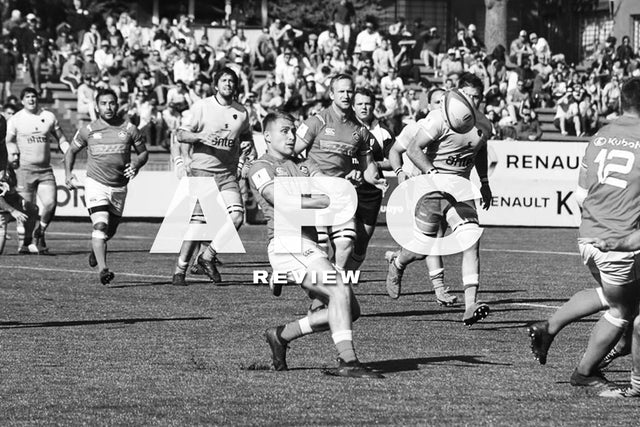What Was Learned from the Americas Pacific Challenge
By: Adam McQueen
The Americas Pacific Challenge almost spelled disaster for the USA Select XV and Canada ‘A’.
Heading into the final round of action on Sunday, the North American sides combined to post an 0-4 record along with a -78 point differential. Thankfully, Canada pulled out an inspiring come-from-behind victory over Tonga ‘A’ to salvage some momentum heading into the November repechage. However, the USA continued to look listless in a 55-15 hammering at the hands of Argentina XV to close a dismal tournament.
So what did we learn?
First and foremost, there will be no new faces cracking the USA Eagles match-day lineup once the November international window rolls around. The Eagles have been flawless in 2018, fielding a consistent lineup, and the winless Selects team did themselves no favours down south. The one player that has reentered the USA picture is winger Ryan Matyas, who was already on the cusp of the June roster. Flanker Hanco Germishuys and center Dylan Audsley are the only other APC attendees that maintained their place in the Eagles travelling squad.
Amidst the recent news that incumbent fly-half AJ MacGinty will once again go under the knife to repair a torn labrum, Selects #10s J.P. Eloff and Conor Kearns had a glimmer of hope that they would receive a call-up. However, neither halfback nudged themselves into the Eagles’ picture with their play in Uruguay. Kearns – the Selects captain – was far more effective when moved back into the fullback position. Eagles coach Gary Gold noted that the additional players may be introduced, yet it seems that Will Magie and Will Hooley will don the fly-half responsibilities.
The USA Select XV squad was clearly a development side that blooded plenty of newcomers to the international stage. Nevertheless, there was enough experience and talent within the team to compete and potentially win the tournament. The only player that truly stood out was the aforementioned Matyas who dotted down a handful of electrifying tries.
Although the Select XV put together flowing attacks that resulted in some highlight reel tries, it was clear that defense had been an afterthought during training camp. The hot, humid climate in Montevideo promoted expansive attacking rugby across the tournament, subsequently sapping the energy from the defense side of the ball.
At the heart of the USA’s defensive woes was the lack of physicality in their forward pack. The heat clearly drained the Americans’ defensive line speed. Gaps began to emerge in the midfield after several phases of opposition attack. To make matters worse, the set-piece was exposed by the hulking forwards from Uruguay and Argentina that constantly put the Selects on the back foot.
Nevertheless, it was a baptism of fire for the younger players, and results were not at the forefront of the selectors’ minds when comprising the Selects team. The APC will provide invaluable experience for the likes of Chance Wenglewski, Mika Kruse, and Vili Toluta’u, who will no doubt be called upon to compete in international competition.
Canada’s tournament seemed destined to follow in the USA’s footsteps. However, a winless tournament would be far more harrowing for a team that included many full Canadian representatives. The two comprehensive losses against Uruguay and Argentina did little to quell the nervousness that surrounds their impending repechage tournament in November.
That said, the immense victory over Tonga ‘A’ brought a breath of fresh air to fans and players alike. The Canadians were resolute in turning around a 15-point deficit in the dying moments of the game, firing a handful of spectacular tries to secure a 32-31 win. The combination of satisfaction and relief was palpable amongst the Canadian side once the final whistle blew.
So, what was different about this Canadian performance?
The work up-front has to be commended. The Canadian scrum was relentless from the opening whistle, and their driving maul spearheaded two of the five tries on the day. In the past, Canada’s defense has faded in the final quarter of games, yet in this match the team remained accurate and disciplined against an incredibly athletic Tongan team that consistently applied pressure by offloading in contact.
While the hard work put in by the forwards mended Canada’s defensive frailties, it was the new-found confidence in the backline that contributed to some dazzling scores.
Throughout this season, the combination of hesitancy and slow ball has hamstrung the creativity of the Canadian attack. However, the running threat of Theo Sauder – who has staked a claim on the starting fullback jersey – and Kainoa Lloyd has injected a dynamic element to a backline that was growing stale. The second of Lloyd’s three tries on the day was jaw-dropping – the winger galloped through the Tongan defense from over forty meters out to cap an incredible solo try. His ability to shed tacklers and finish one-on-one situations is unparalleled.
Veterans Phil Mack, Nick Blevins, and Gordon McRorie are essential cogs to the Canadian team – their experience and consistency keeps the ship moving. However, introducing youngsters who are daring in attack, such as Sauder and Lloyd, is a perfect compliment to the veteran contingent. The load on Blevins’ shoulders to create a spark is significantly lessened when game-breakers are present in the wider channels who can attack the following phase. The Calgary-born center can return to what he does best: earning the gain-line with bruising carries.
Finishing the APC with a 1-2 record should not be the benchmark of success for Canada. However, the final performance was a step in the right direction. It reminded all of us watching that Canada is capable of playing quality rugby. The real test will come during the November repechage when the stakes will be at their highest, but for now Canada can take a sliver of momentum forward as they prepare for the biggest games in their history.


